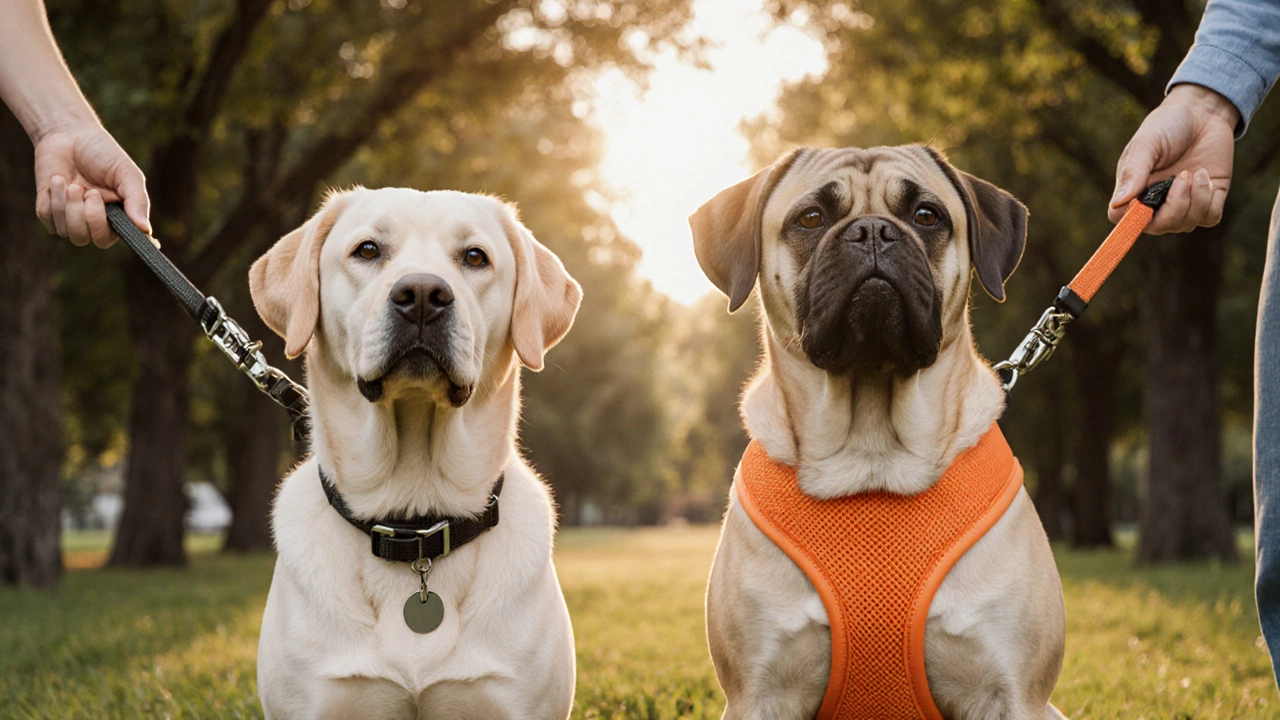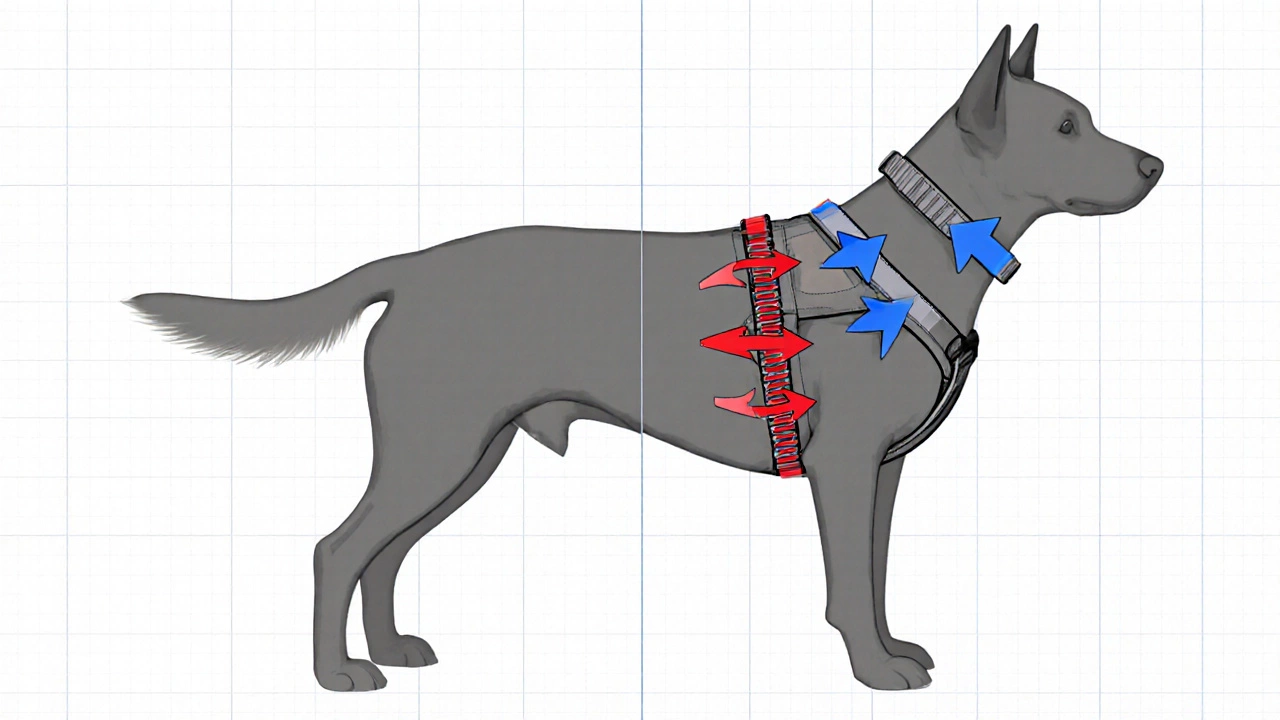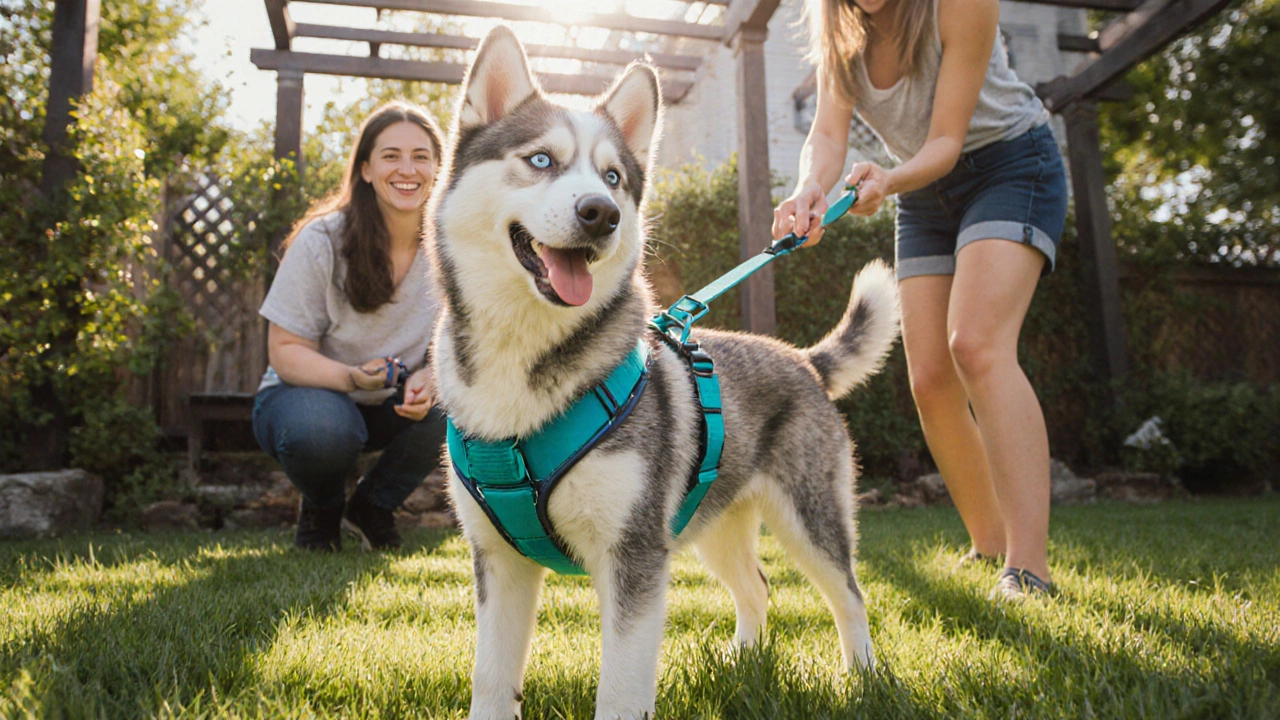
Ever wondered why some owners swear by a dog collar is the only way to keep their pup on a leash, while others never leave the house without a dog harness strapped on? The debate isn’t just about style - it’s a safety showdown that can affect your dog’s neck, spine, and even behavior.
What a Dog Collar Actually Is
Dog Collar is a band that wraps around a dog's neck, typically made of nylon, leather, or fabric. Its primary purpose is to hold identification tags and provide a point to attach a leash. Because it sits on the neck, the collar distributes pulling force across the throat, which can be harmless for a relaxed walk but risky if the dog lunges or jerks.
What a Dog Harness Looks Like
Dog Harness is a vest‑style piece that encircles the chest and sometimes the ribs. It connects to a leash at the front, the back, or both, spreading any pulling force across a larger surface area. Harnesses come in various styles: front‑clip for training, back‑clip for comfort, and dual‑clip for versatility.
Why the Choice Matters: Anatomy and Safety
When a dog pulls, the force travels through the attachment point. With a collar, that force is concentrated on the neck and underlying windpipe. Sudden jerks can compress the trachea, cause bruising, or even damage a delicate cervical spine in small breeds.
A harness moves the pressure to the chest and shoulders. The ribcage can absorb more load without lasting injury, making it a safer option for strong pullers, large breeds, and dogs with pre‑existing neck issues.
Behavioral Impact: Pulling and Training
Dogs that love to pull can be taught to brake with the right equipment. A front‑clip dog harness redirects the dog’s momentum toward the owner, creating a natural “stop” cue. This is especially helpful in early training and for breeds known for pulling, like Huskies or Labrador Retrievers.
Collars, on the other hand, give no directional feedback. If a dog is a relentless tugger, the owner often has to resort to harsh corrections or a choke chain, which can strain the neck and damage the trust between pet and owner.
Breed‑Specific Considerations
- Small breeds (e.g., Chihuahua, French Bulldog): A lightweight, padded collar works fine, but a well‑fitted harness prevents accidental choking if they slip out of the collar.
- Medium breeds (e.g., Beagle, Cocker Spaniel): Both options are viable; choose a harness if the dog tends to pull or has a short neck.
- Large breeds (e.g., German Shepherd, Mastiff): Harnesses are generally recommended because the force generated by a big dog can seriously injure the neck when using a collar.

Practical Checklist: Picking the Right Gear
- Measure your dog’s neck and chest accurately. Add 2‑3 inches for a comfortable fit.
- Check for padded interiors. Padding reduces friction on both neck and chest.
- Consider the walk style. If you’re training loose‑leash walking, a front‑clip harness is a game‑changer.
- Look at durability. Nylon or polyester straps with metal buckles survive daily use better than cheap fabric.
- Test for escape. Tug gently on both collar and harness; a proper fit should stay put.
Side‑by‑Side Comparison
| Feature | Dog Collar | Dog Harness |
|---|---|---|
| Pressure Point | Neck (trachea, cervical spine) | Chest & shoulders (ribcage) |
| Best For | Small, calm dogs; identification | Pullers, large breeds, dogs with neck issues |
| Training Aid | Limited (no directional control) | Front‑clip redirects pull, back‑clip offers comfort |
| Escape Risk | Higher (can slip out if loose) | Lower (multiple attachment points) |
| Weight | Light (under 100 g) | Heavier (100‑300 g depending on material) |
| Cost Range (USD) | $5‑$25 | $15‑$60 |
When a Collar Is Still the Right Choice
If your dog is a well‑behaved indoor companion who rarely pulls, a simple collar does the job. It’s quick to put on, cheap, and perfect for attaching ID tags and a lightweight leash.
Veterinarians often recommend a soft, padded collar for dogs with sensitive skin or neck problems, as long as the owner monitors for any signs of irritation.
When a Harness Is Non‑Negotiable
Any dog that lunges at squirrels, yanks on the leash, or has a short, thick neck (think Bulldogs) benefits from a harness. For dogs recovering from neck surgery, a harness keeps the surgical site untouched while still allowing controlled walks.
Professional trainers almost always start new clients with a front‑clip harness because it gives instant feedback without hurting the animal.

Common Mistakes and How to Fix Them
- Too tight. If you can’t fit two fingers under the strap, it’s too snug and may cut off circulation.
- Too loose. A loose collar or harness can chafe or get caught on obstacles, leading to sudden pulls.
- Wrong attachment point. Attaching the leash to a back‑clip harness on a strong puller gives the dog leverage to jump forward.
- Ignoring wear. Frayed straps or broken buckles can snap mid‑walk-inspect gear weekly.
Expert Tips from Veterinarians and Trainers
Dr. Elena Martinez, a canine orthopedist, says: “A harness is the safest default for most dogs. The only time I’d prescribe a collar alone is when the dog’s gait is completely relaxed and the owner is diligent about fit.”
Professional trainer Marco Ruiz adds: “Start every new leash session with a front‑clip harness. It gives you the ‘stop‑on‑pull’ cue without choking the dog, and you’ll see faster progress.”
Quick Decision Guide
Use this three‑step flow to decide:
- Ask: Does my dog pull hard? Yes → Harness. No → Continue.
- Check health: Any neck or trachea issues? Yes → Harness. No → Continue.
- Consider size: Is my dog a large or deep‑chested breed? Yes → Harness. No → Collar works.
Final Thoughts
Both collars and harnesses have a place in a dog owner's toolkit. The key is matching the gear to your dog’s build, behavior, and any medical concerns. When in doubt, a well‑fitted harness offers the most protection and training advantage, while a soft collar remains perfect for everyday ID and brief, relaxed walks.
Can a dog wear a collar and a harness at the same time?
Yes, many owners put a lightweight collar for tags and a harness for walking. Just make sure the collar isn’t too tight and the harness fits properly.
What’s the best material for a dog harness?
Nylon with padded polyester mesh is durable and comfortable. For hot climates, look for breathable, moisture‑wicking fabrics.
How often should I replace my dog’s collar or harness?
Inspect gear every month. Replace if you notice fraying, broken buckles, or loss of elasticity-typically every 12‑18 months for heavy‑use items.
Is a front‑clip harness better for training than a back‑clip?
Front‑clip designs give instant directional feedback, helping dogs learn to stop pulling without choking. Back‑clip is more for comfort once the dog already walks loosely.
Can a collar cause breathing problems?
A too‑tight collar can compress the trachea, especially in brachycephalic breeds like Pugs. Always ensure you can fit two fingers under the collar.




